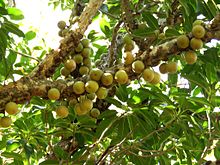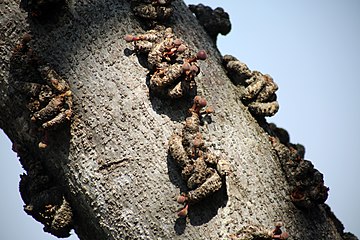
Ficus is a genus of about 850 species of woody trees, shrubs, vines, epiphytes and hemiepiphytes in the family Moraceae. Collectively known as fig trees or figs, they are native throughout the tropics with a few species extending into the semi-warm temperate zone. The common fig (F. carica) is a temperate species native to southwest Asia and the Mediterranean region, which has been widely cultivated from ancient times for its fruit, also referred to as figs. The fruit of most other species are also edible though they are usually of only local economic importance or eaten as bushfood. However, they are extremely important food resources for wildlife. Figs are also of considerable cultural importance throughout the tropics, both as objects of worship and for their many practical uses.

Strangler fig is the common name for a number of tropical and subtropical plant species in the genus Ficus, including those that are commonly known as banyans.

Ficus lyrata, commonly known as the fiddle-leaf fig, banjo fig, fiddle-leaved fig tree, lyre leaf fig tree, or lyre-leaved fig tree, is a species of plant in the mulberry and fig family Moraceae. It is native to western Africa, but is cultivated around the world as an ornamental plant. It has received the Royal Horticultural Society's Award of Garden Merit.
Ficus crassiuscula is a species of flowering plant in the family Moraceae, native to Central America and north-western parts of South America.

Ficus aurea, commonly known as the Florida strangler fig, golden fig, or higuerón, is a tree in the family Moraceae that is native to the U.S. state of Florida, the northern and western Caribbean, southern Mexico and Central America south to Panama. The specific epithet aurea was applied by English botanist Thomas Nuttall who described the species in 1846.

Ficus americana, commonly known as the West Indian laurel fig or Jamaican cherry fig, is a tree in the family Moraceae which is native to the Caribbean, Mexico in the north, through Central and South America south to southern Brazil. It is an introduced species in Florida, USA. The species is variable; the five recognised subspecies were previously placed in a large number of other species.

Ficus sur, with the common names Cape fig and broom cluster fig, is a widespread Afrotropical species of cauliflorous fig.

Ficus craterostoma, a species of strangler fig, is a fig shrub or tree of the Afrotropics that may grow up to 20 m tall. It is found in lowland tropical and swamp forests in the west, or in afromontane forests, including rocky situations, along Africa's eastern escarpments. The western and eastern populations may constitute separate species, as they occur at different altitudes where their ranges meet in central Africa, while they seem to have exclusive pollinating wasp species.
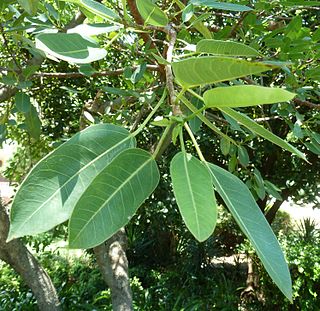
The Wonderboom is an evergreen fig species that ranges from the KwaZulu-Natal midlands northwards to tropical East Africa. It grows especially on outcrops, rocky hillsides and along cliffs fringing water courses and may rarely grow up to 10 m (33 ft) tall, and acquire a leafy spreading crown.

Ficus ingens, the red-leaved fig, is a fig species with an extensive range in the subtropical to dry tropical regions of Africa and southern Arabia. Despite its specific name, which means "huge", or "vast", it is usually a shrub or tree of modest proportions. It is a fig of variable habit depending on the local climate and substrate, typically a stunted subshrub on elevated rocky ridges, or potentially a large tree on warmer plains and lowlands. In 1829 the missionary Robert Moffat found a rare giant specimen, into which seventeen thatch huts of a native tribe were placed, so as to be out of reach of lions.
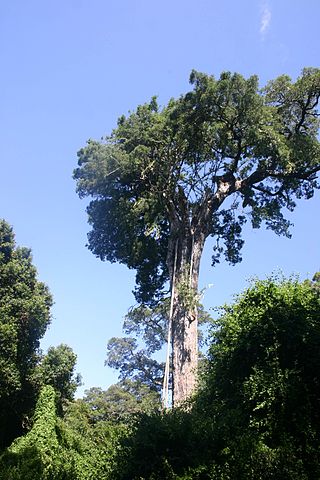
Ficus burtt-davyi is a fig species endemic to Southern Africa, belonging to the Mulberry family of Moraceae. It grows in coastal and inland forests up to 1,500 m (4,920 ft), from the vicinity of Mossel Bay in the Southern Cape to southern Mozambique - the forms growing on coastal dunes in the northern part of its range are salt tolerant and form low thickets on the margins of woodland. In the southern and eastern Cape forests the species becomes a strangler or liana, while when found on rocky outcrops and cliffs it usually develops into a rock-splitter.

Ficus vasta, is a fig plant found in Ethiopia and Yemen. The tree is a species of sycamore-fig.
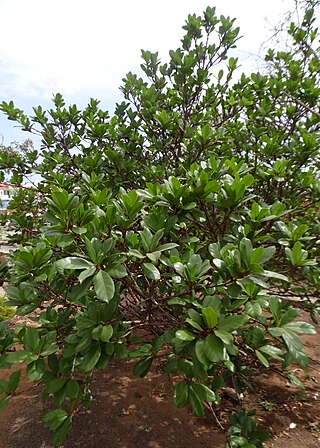
''Ficus cyathistipula'', the African fig tree, is a species of fig that is native to the tropical forest regions of Africa. They may be small trees, shrubs or hemi-epiphytic lianas, and are widespread in the moist tropics, where they may be found in Afromontane or rainforest, often overhanging pools. The figs are reddish when ripe, and have thick, spongy walls that enable them to float on water. They are named for their cup-shaped (cyathus-) and persistent stipules (stipula).

Trilepisium madagascariense, the urnfig or false-fig, is a species of plant in the family Moraceae, with an extensive range in the subtropical and tropical Afrotropics. It grows to a medium-sized or large tree in primary or secondary forest, or in forest patches, and is rarely cultivated.
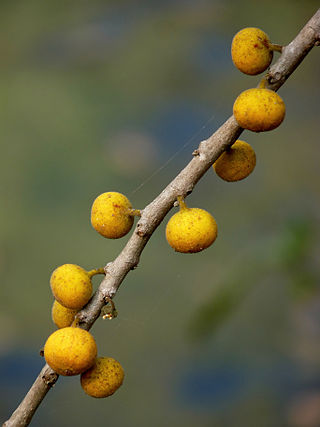
Ficus exasperata, also called the sandpaper tree, forest sandpaper fig, white fig, or sandpaper leaf tree, is a deciduous, and dioecious species of plant in the mulberry family Moraceae, native to tropical Africa and southern Asia.

Boscia foetida, commonly known as the stink shepherd's tree and the smelly shepherd's bush, is an evergreen shrub or tree that is native to the warmer and drier parts southern Africa. It is found in semi-desert and arid bushveld, and in the west it occurs commonly in areas which are otherwise sparsely wooded. It is known for the particularly unpleasant smell of its flowers which appear during early spring, to which its specific name foetida alludes. Its freshly cut wood likewise has an unpleasant smell, and has traditional medicinal and magical uses, for instance as a protection against lightning. In central Botswana the village of Mopipi is named after this species.

Gardenia volkensii, commonly known as bushveldt gardenia or Transvaal gardenia, is a species of plant in the family Rubiaceae native to southern Africa.
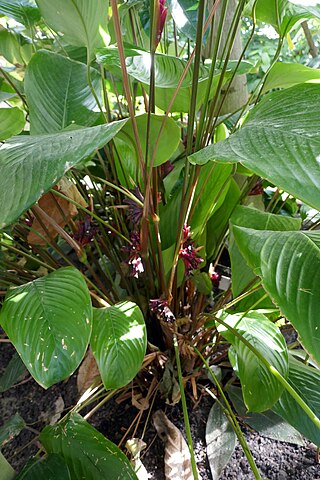
Ficus vallis-choudae is a shrub or small to medium sized tree within the family Moraceae, in the genus Ficus and sub-genus, Sycomorus.

Ficus laurifolia is an hemi-epiphytic species that sometimes grows as a shrub or liana or as a tree, the species is within the family Moraceae.
Ficus tremula is an hemi-epiphytic species within the family Moraceae. It is pollinated by the fig wasp, Courtella wardi.

